.jpg)
Starting a balcony garden from scratch is an exciting way to bring nature into your urban home.
Even if you only have a small apartment balcony garden setup, you can transform it into a thriving green oasis.
This beginners guide to starting a balcony garden will walk you through everything – from planning your space and choosing the best plants for balcony containers to clever DIY balcony gardening tips and maintenance.
By the end, you’ll be ready to start a balcony garden of your own with confidence (and have fun doing it!).
Why Start a Balcony Garden?
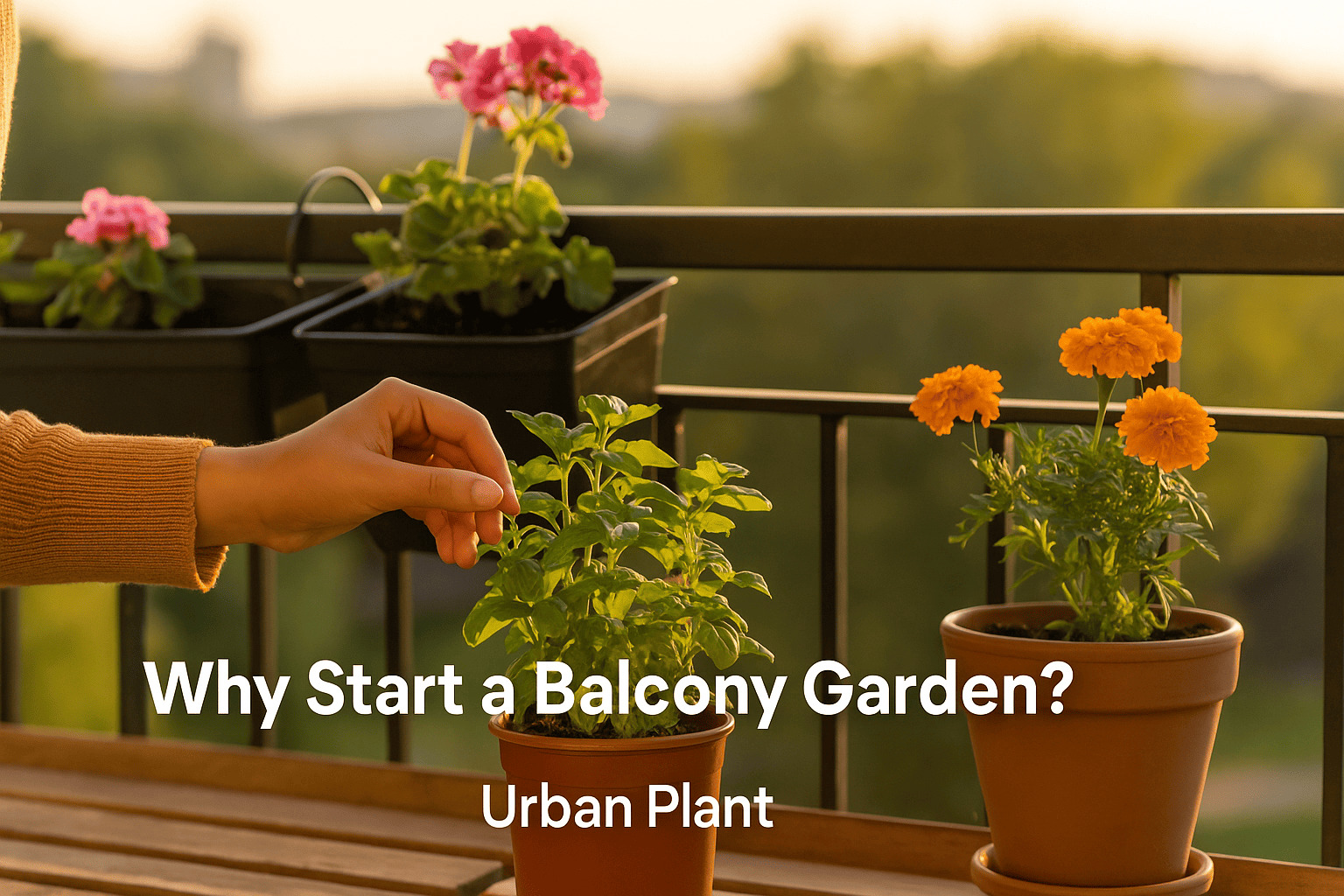
A balcony garden is more than just decor – it comes with a bundle of benefits for you and the environment.
Tending to plants is a natural stress reliever; studies show that even small green spaces or potted plants can help reduce stress and improve your mood.
After a long day, stepping onto a balcony filled with greenery can help you relax and feel calmer.
You’ll also get to enjoy fresh air and a prettier view (much nicer than staring at concrete walls!).
There are practical perks too. Plants produce oxygen and can improve air quality around your home.
A bit of balcony greenery may even cool your apartment slightly on hot days – research found that balcony gardens can reduce indoor temperatures by up to 2.5°C in tropical climates.
If you grow edible plants, you’ll have fresh herbs, veggies or fruits at your fingertips, elevating your home cooking.
Plus, for the eco-conscious, a balcony garden is a small step toward supporting urban biodiversity (think pollinators like butterflies and bees visiting your flowers).
In short, starting a balcony garden is good for your mental well-being, your living space, and the planet.
It’s amazing how much joy a tiny urban garden can bring!
Read More Gardening Tips
10 Stunning Balcony Garden Ideas for Indian City Homes
Surprising Health Benefits of Gardening for Reducing Mental Stress
Planning Your Balcony Garden
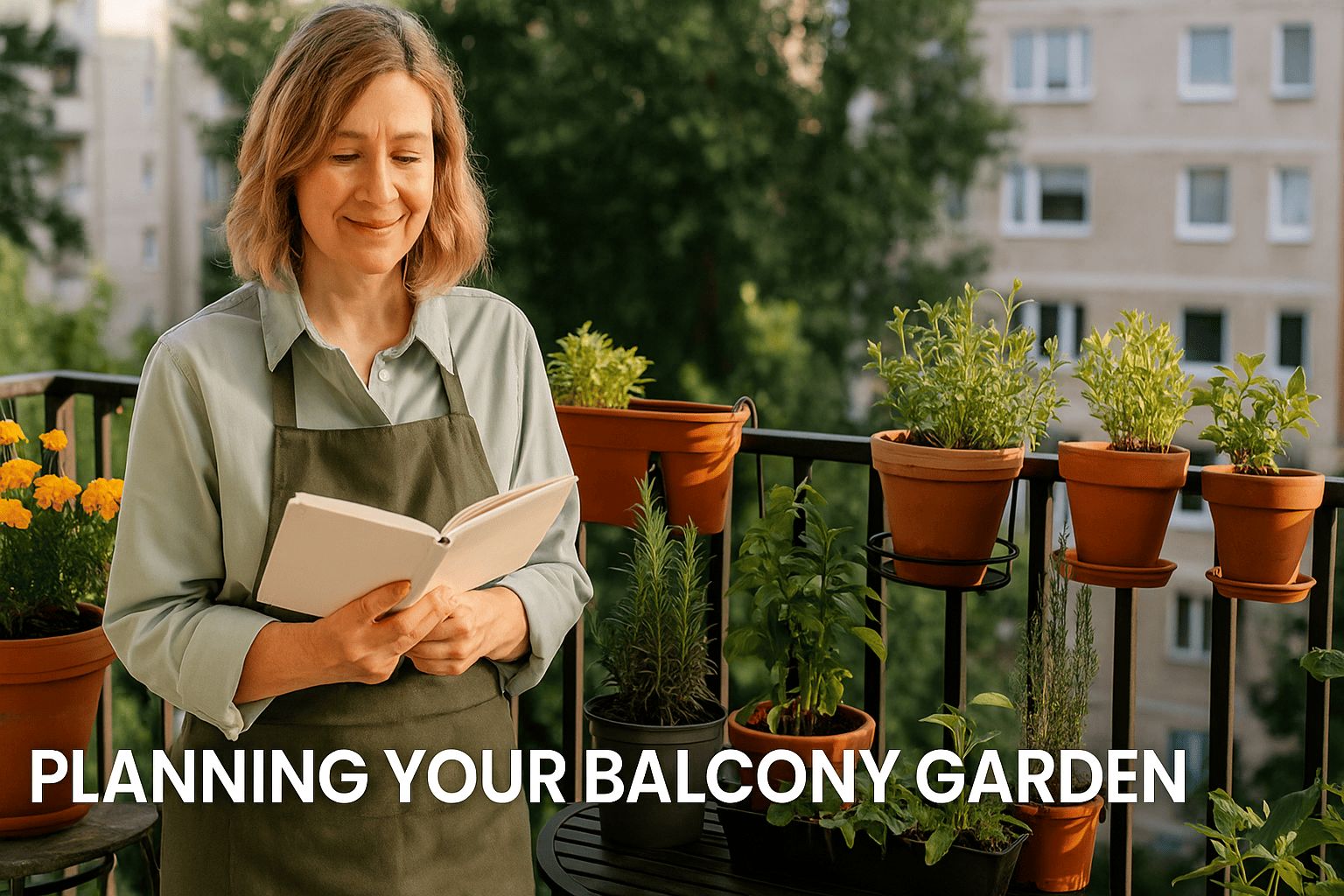
Before you start buying pots and plants, a little planning will set your balcony garden up for success. Think of this as laying the groundwork (pun intended):
1- Assess Your Space and Sunlight
Take a close look at your balcony. How much floor area and railing space do you have? Is it sheltered or exposed to wind and rain?
Just as important, observe how much sun your balcony gets throughout the day.
Most vegetables and flowers need 6–8 hours of sun daily, so a south or east-facing balcony is ideal for sun-loving plants.
If you have a north-facing or shaded balcony, don’t worry – you can choose shade-tolerant plants like lettuce, spinach, ferns or pothos which thrive with less light.
Knowing your sunlight conditions will guide what you can grow.
2- Check Building Guidelines and Weight Limits
If you live in an apartment building, be sure to check your building’s rules or guidelines for balconies.
Some housing complexes prohibit attaching planters outside railings or have weight limits for safety.
Wet soil can get heavy, and you don’t want to overload a cantilevered balcony.
Spread out heavy pots rather than clustering them in one spot.
It’s also wise to use trays under pots to catch excess water so it doesn’t drip down on your neighbors.
3- Define Your Purpose and Style
Ask yourself what you want from your balcony garden. Is it a kitchen garden for cooking (fresh herbs, veggies), a tranquil flower retreat for relaxation, or maybe a bit of both? “Before deciding what to grow, consider your garden’s overall purpose,” advises Jen McDonald, an organic garden specialist.
For example, if you want beauty and color, focus on flowering plants.
If your goal is fresh ingredients, start with easy herbs or salad greens.
Love to bird-watch or support pollinators? Add native flowers or a small bird-friendly water dish.
Defining a theme helps you prioritize plants and design – whether it's a calming zen garden with leafy foliage or a vibrant mix of edibles and blooms.
4- Plan the Layout (Think Vertical!)
In a tight space, creativity is key. Map out where you can place plants: floor, walls, railings, even hanging from the ceiling. “I love using wall planters or a little vertical ladder shelf for pots,” says Anna Ohler, owner of a urban gardening store.
Going vertical is one of the best balcony garden ideas for beginners to maximize space – use hanging baskets on overhead hooks or railing planters that latch onto the balcony railing.
If floor space is limited, consider a multi-tiered plant stand (like a ladder rack or shelves) to stack pots upward.
Hanging planters are a game-changer for trailing plants or strawberries, and railing planters let you add flowers along the edge without taking floor space.
Just remember not to crowd every inch; leave a little room for you to move or sit outside. “Make sure the space is not only beautiful, but also functional,” Ohler notes– you’ll enjoy your balcony more if you can actually step out, relax, and tend your garden comfortably (maybe add a small folding chair or fairy lights for ambiance).
5- Mind the Environment
Higher floors can be windy, which may dry out pots faster or topple lightweight containers.
You might need to position larger, heavier pots as windbreaks or secure hanging pots well so they don’t swing.
If your area gets heavy rain, ensure your pots have good drainage so roots don’t drown. Little considerations like these in the planning stage will save headaches later.
By planning out these basics – space, sun, rules, style, and layout – you’re laying a solid foundation.
Now, let’s move on to gathering what you need for your small balcony garden.
Essential Containers, Tools, and DIY Tips
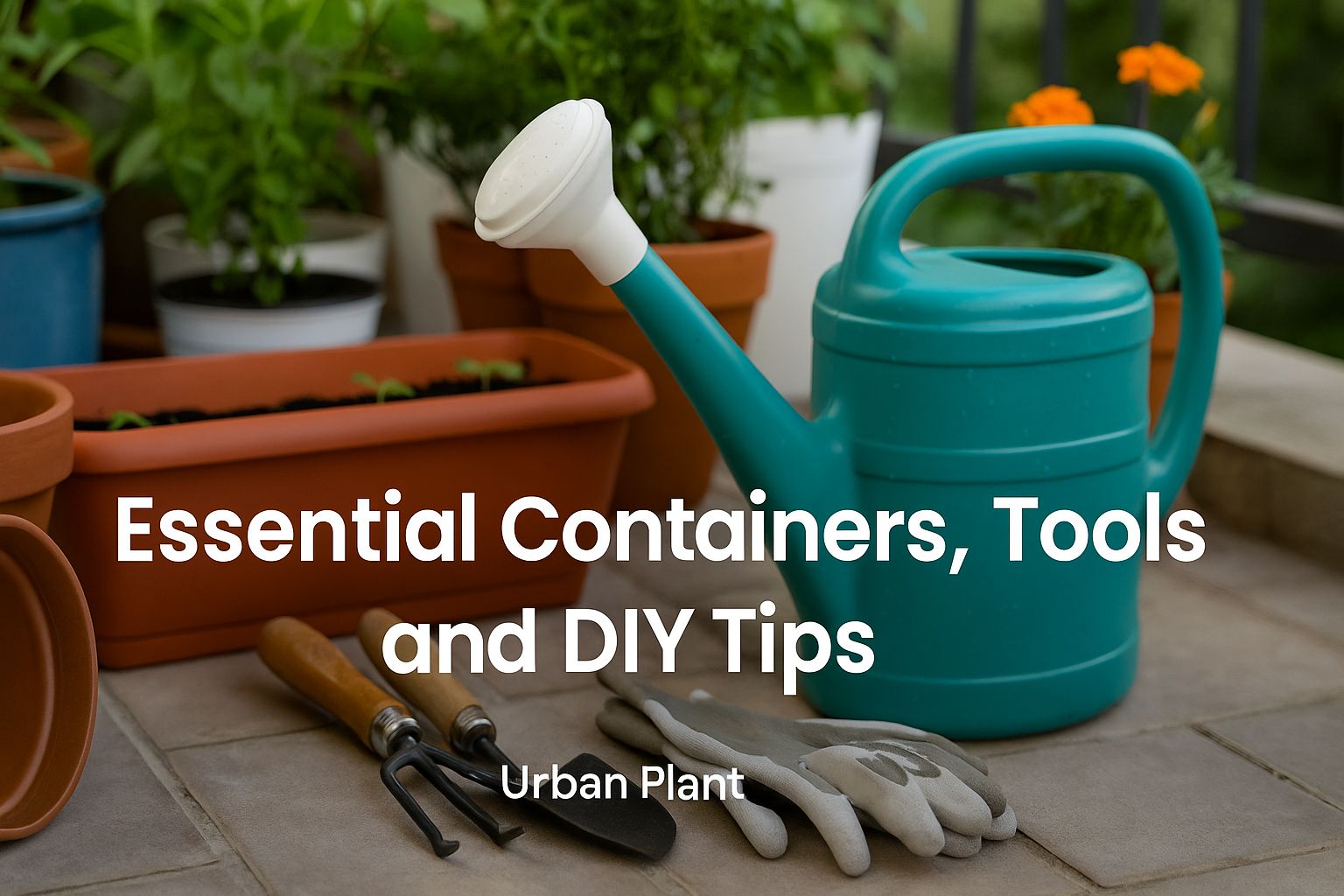
Getting your materials together is the next step in starting a balcony garden from scratch.
The good news is you don’t need a yard or fancy equipment – just a few essentials:
1- Containers & Planters
Almost any container can become a planter as long as it’s sturdy and has drainage holes.
Traditional pots (terracotta, plastic, ceramic) are great; choose sizes appropriate to your plants (small pots for herbs, deeper ones for tomatoes, etc.).
If floor space is tight, look for space-saving planters like railing planters or wall-mounted pots.
For example, Urban Plant’s Pots & Planters section offers durable yet stylish options for small spaces, including self-watering pots that take the guesswork out of watering.
You can also get creative with DIY containers: use old buckets, wooden crates, or even plastic bottles with holes (great for herbs).
Just ensure good drainage – waterlogged soil will harm roots.
Pro Tip: Place a tray under pots to catch soil and water runoff, especially if you’re in an apartment and want to keep the balcony clean.
2- Potting Mix (Soil)
Don’t skimp on the soil! Plants in containers rely entirely on the potting mix you provide. Use a lightweight, well-draining potting mix rather than plain garden soil.
Quality potting mix typically contains ingredients like cocopeat or peat moss (for holding moisture), perlite or sand (for drainage), and compost or fertilizer for nutrients.
This mix retains moisture but still drains excess water – important for container plants. Before filling pots, you can place some gravel or broken pot pieces at the bottom to improve drainage.
For organic nutrition, mix in a bit of compost or well-rotted manure.
(You can find organic vermicompost and fertilizers in the Urban Plant Plant Care section if you need supplies
3- Tools & Accessories
You won’t need heavy-duty tools, but a few basic gardening tools will make balcony gardening easier.
A small hand trowel (for digging and potting), a pair of pruning shears (for trimming plants), and gardening gloves are must-haves.
A watering can with a narrow spout is extremely handy for directing water into pots without making a mess.
Other useful items include a small hand fork or cultivator (to loosen soil), and spray bottle for misting or pest control.
You can buy these items separately or as a kit – for instance, Urban Plant offers a 7-Piece Essential Gardening Tools Kit that contains a trowel, cultivator, fork, weeder, pruner, and gloves, all designed for urban gardeners in compact spaces.
A kit like this ensures you have all the tools you need from the get-go.
4- Watering Setup
Regular watering is crucial, so plan how you’ll do it. If you have an outdoor faucet, great – otherwise, a watering can or a lightweight hose that connects to your indoor tap works.
One clever DIY balcony gardening tip many gardeners use is a drip irrigation hack: take a plastic water bottle, pierce a tiny hole in the cap or bottom, fill it with water, and invert it into a pot – it will slowly drip water into the soil.
“Take a water jug, poke a small hole in the bottom and one in the top, fill it and place it next to your plant,” one balcony gardener suggests, for an easy slow-release watering system.
This can be a lifesaver on hot days or when you’re away for a couple of days. Just be mindful of not creating stagnant water (to avoid mosquitoes).
5- Miscellaneous
A few more items can enhance your balcony garden. Consider a bag of small pebbles or mulch – a thin layer on top of soil can help retain moisture and decoratively cover the dirt.
If you’re worried about water dripping, get some plastic saucers or trays for under pots.
For vertical setups, wall hooks or macrame hangers can be useful to hang planters.
And if pests like pigeons or squirrels visit, you might need some netting or mesh to protect young plants (or simple pinwheels and shiny ribbons can deter birds).
DIY Tip: Repurpose and recycle to save money – an old bookshelf can serve as a plant stand, wooden wine crates can be lined with plastic and turned into planter boxes, and take-out containers can start seedlings.
Balcony gardening is a chance to get creative! Now that you have containers, soil, and tools ready, let’s talk about what to grow.
Choosing the Best Plants for a Balcony Garden
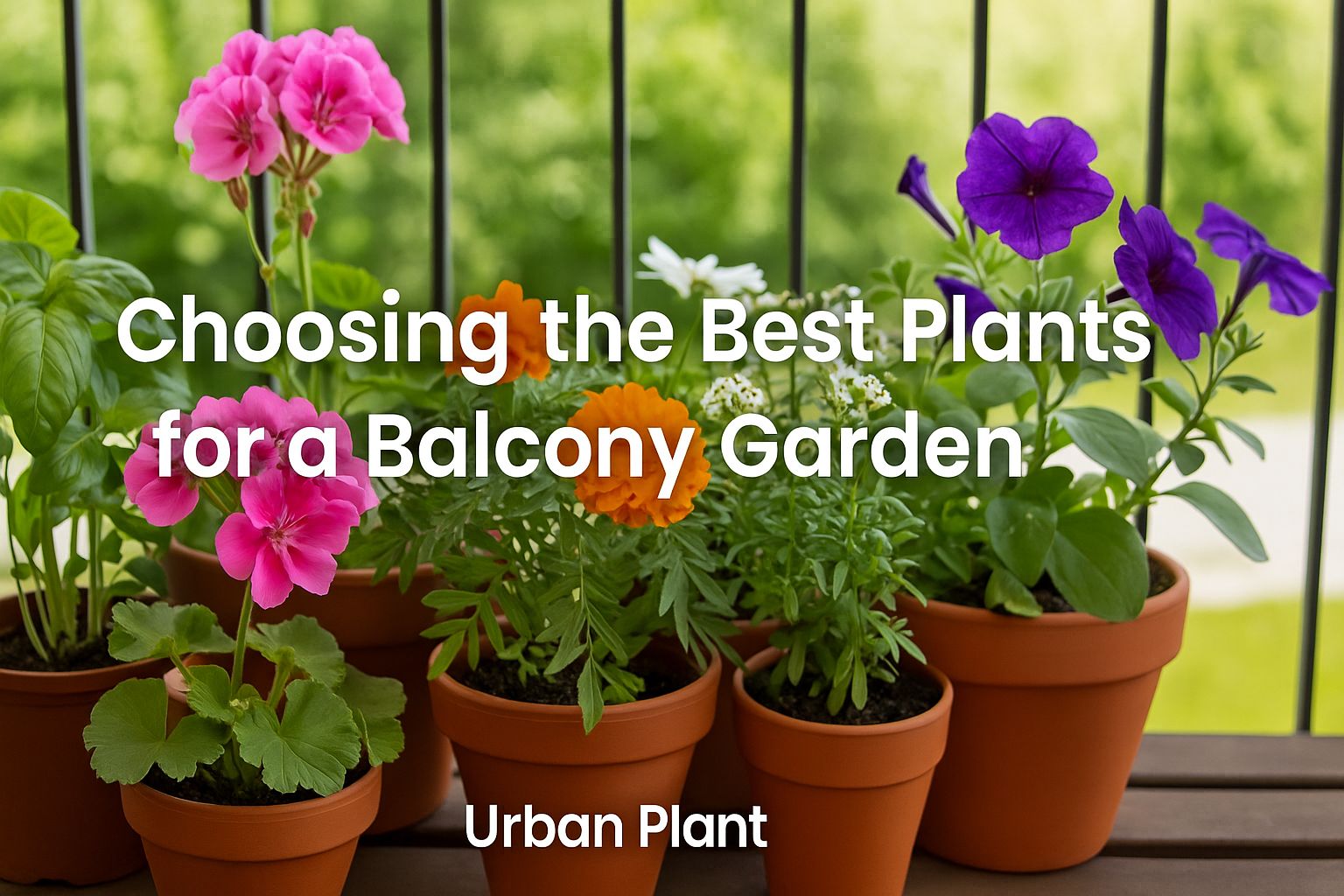
One of the most exciting parts of starting a balcony garden is picking out the plants!
The best plants for balcony gardens are those that fit your space, light, and climate conditions – and of course, those that you personally enjoy.
Here are some suggestions (ideal for beginners):
1- Herbs and Leafy Greens
Herbs are superstar plants for small gardens – they’re easy, useful, and many do well in pots.
Basil, mint, cilantro (coriander), parsley, thyme, and rosemary are great herbs to start with.
They don’t take much space and can be snipped as needed for cooking. Leafy greens like lettuce, spinach, kale, or fenugreek (methi) also thrive in shallow containers and partial sun.
Imagine having a fresh salad straight from your balcony! Most greens prefer cooler, partial sun conditions, so they can work on less sunny balconies too.
2- Vegetables in Containers
Yes, you can grow veggies on a balcony. Choose compact or dwarf varieties that don’t need sprawling space.
Cherry tomatoes, chili peppers, baby eggplant (brinjal), bush beans, radishes, and spring onions are all doable in pots.
You’ll need at least 5–6 hours of sun for fruiting veggies like tomatoes or chilies, and use deeper pots (8-12 inches) for their roots.
Don’t overcrowd; one tomato or pepper plant per medium pot is usually best.
With good sunlight and regular feeding, you might be harvesting your own balcony tomatoes or okra in a few months – how rewarding is that?
Pro tip: Start with seedlings from a nursery for veggies like tomatoes or peppers if possible, as it’s faster than germinating seeds for beginners.
3- Flowers and Ornamentals
For a splash of color and fragrance, incorporate some flowering plants. Marigolds, petunias, geraniums, and nasturtiums bloom brilliantly in pots.
Marigolds are sunny and easy to grow (bonus: they repel some pests). Petunias trail nicely in hanging baskets. If you have partial shade, impatiens or begonias can add color.
You could also try fragrant flowers like jasmine or gardenias in warm climates – a whiff of sweet scent can transform your balcony evenings.
Don’t forget decorative foliage plants too: for example, coleus has stunning colorful leaves (as seen in the image below alongside a pot of mint), and succulents or cacti bring interesting shapes while being very low-maintenance.
4- Low-Maintenance Greens
If you’re the forgetful type or travel often, succulents and cacti might be your best friends.
These hardy plants (like jade plant, echeveria, or snake plant) can tolerate infrequent watering and still flourish.
If you’re the forgetful type or travel often, succulents and cacti might be your best friends.
These hardy plants (like jade plant, echeveria, or snake plant) can tolerate infrequent watering and still flourish.
Money plant (pothos) and snake plant are popular indoor-outdoor plants that are tough and also help purify air.
They’re great for beginners because they forgive mistakes. Place them in attractive planters to decorate empty corners or shelves.
Expert Tip: “Is your balcony garden for beauty? Then plant annual flowers. Is it for cooking? Start with herbs, which require little space but have maximum impact,” says Jen McDonald.
In other words, tailor your plant choices to what you’ll enjoy the most – a little personal touch goes a long way in making your balcony garden meaningful to you.
Setting Up Your Balcony Garden (Planting Day!)

Now comes the fun part – setting everything up! By this stage, you’ve planned your layout, gathered containers, soil, and chosen plants.
Here’s how to bring it all together when you start your balcony garden:
1. Prepare the Space
Clear and clean your balcony area. It’s easier to start with an empty, swept space.
If you’re concerned about dirtying the floor, you can lay out a plastic sheet or old newspapers while potting (then remove later).
If you have a wooden balcony floor, consider a water-resistant mat in the gardening corner.
2. Place Large Items First
Position any big items like plant stands, shelving units, or large pots in their spots first. It’s simpler to arrange these before they’re filled with heavy soil.
Ensure stability – for instance, a vertical stand should be against a wall for support (and in a spot where it gets the desired sun exposure).
3. Water Thoroughly
After planting, give everything a good drink of water. Water each container until you see excess water start to drip out of the bottom (this ensures the entire soil mass is moist).
For small seedling pots, a gentle sprinkle or using a watering can with a rose attachment (shower head) works best to avoid displacing the soil.
Expect the soil level to settle a bit after the first watering – you can top up with a bit more mix if needed.
4. Finishing Touches
Arrange your pots according to your design – maybe herbs in an easy-to-reach spot near the kitchen door, flowers clustered for color, vines tucked in a corner with their trellis.
If you have hanging planters, hook them up securely and double-check they’re stable. Add any decorative touches like a small stool, outdoor rug, or garden gnome to make the space your own.
Also, consider adding a shallow tray of water with marbles or stones as a butterfly/bee water feeder – it can support local pollinators in a small way.
Now step back and admire your work – you’ve officially started a balcony garden from scratch!
With the initial setup done, the next step is keeping your mini garden healthy and happy.
Caring for Your Balcony Garden
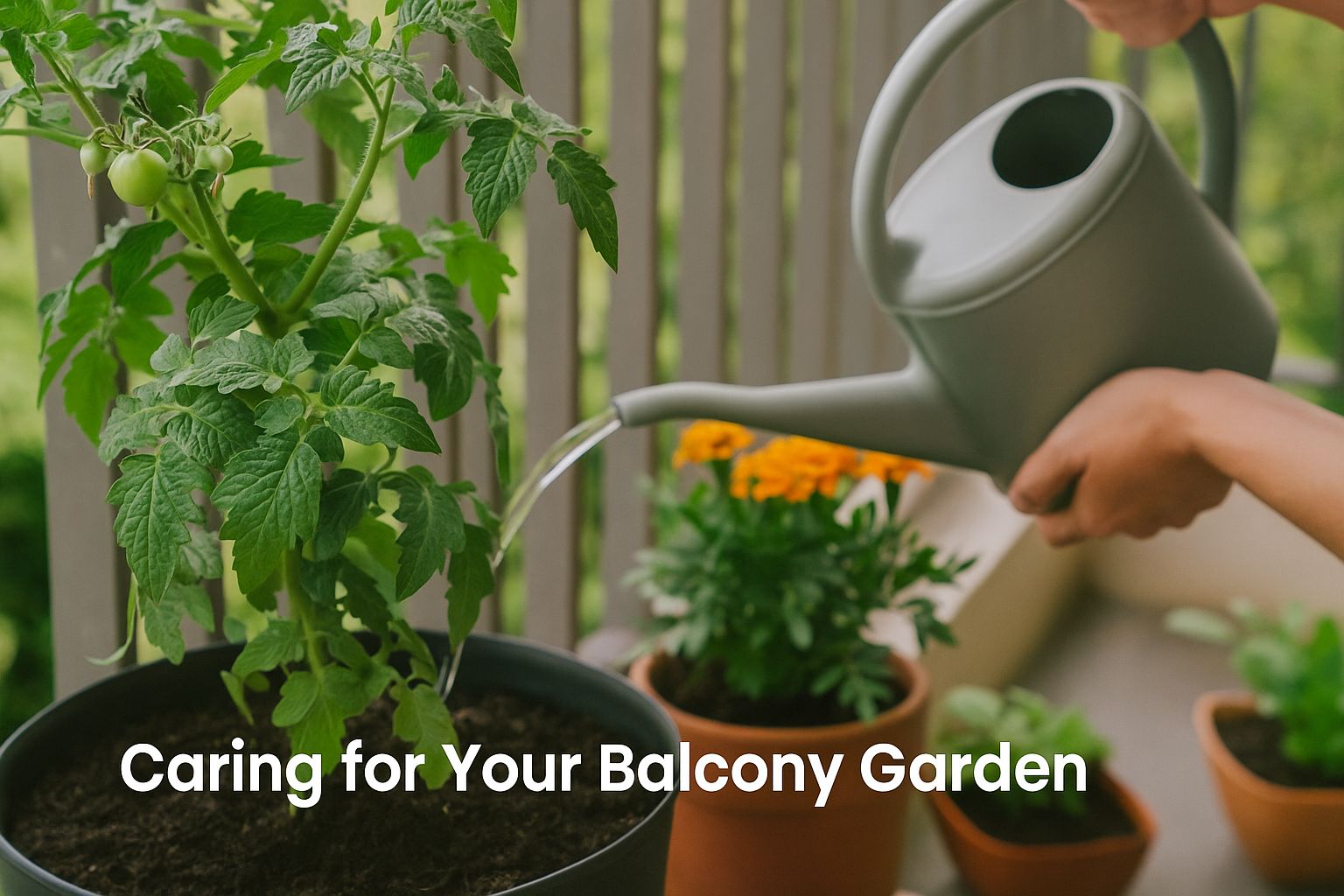
Maintaining a balcony garden is an ongoing process, but it’s not difficult. A little regular care will keep your plants thriving:
1. Watering
Check your plants daily, especially in hot weather. Potted plants can dry out quickly since they can’t pull moisture from the ground.
A simple test: stick your finger about 1 inch into the soil – if it feels dry, it’s time to water.
When you water, do it thoroughly until excess water drains out; this ensures the roots get a good soak.
Tip: Water in the morning or evening when the sun isn’t as strong to reduce evaporation loss.
Also, use a watering can or hose attachment to direct water at the soil level – try not to wet the leaves every time, as that can invite fungal issues.
2. Feeding (Fertilizing)
Because container plants have limited soil, they appreciate some extra nutrients now and then.
You can feed your balcony plants in a couple of ways. One easy method is top-dressing: every month, add a handful of compost or organic manure on top of the soil and lightly mix it in – this slow-releases nutrients.
3. Sunlight and Rotation
Keep an eye on how the sunlight on your balcony changes with seasons.
The sun’s angle can shift, meaning one corner might become shadier in winter and another might get more sun in summer.
Don’t hesitate to move your pots around as needed. If a plant isn’t doing well (e.g., a sun-lover in too much shade, or a delicate fern getting scorched), relocate it to a better spot.
Some experienced balcony gardeners even put pots on wheeled stands to easily roll them into sunny or protected spots as needed.
4. Pruning and Grooming
Regular grooming will keep your balcony garden in top shape. Pinch off dead flowers (deadheading) to encourage more blooms, trim any yellowing or dead leaves, and prune back leggy stems to promote bushier growth.
Herbs like basil and mint actually grow fuller if you pinch them regularly.
If any plant outgrows its pot or looks root-bound (roots coming out of the drainage holes), consider re-potting it into a larger container with fresh soil.
Late winter or early spring is a good time for an annual soil refresh for perennial plants – you can trim back the roots a bit and add new potting mix to rejuvenate the pot.
5. Pest Control
Balconies can get pests too, from common bugs like aphids and mealybugs to caterpillars or even pigeons nibbling on greens. Inspect your plants periodically – check under leaves for tiny insects or eggs.
At the first sign of pests, try organic remedies: for aphids or mites, a simple solution of mild soap and water sprayed on leaves can do wonders (rinse off after a couple hours).
Neem oil is an excellent organic pesticide for many pests and fungal issues – mix a small amount with water and a drop of soap and spritz on affected plants.
Balcony gardening is a learning journey – you’ll discover what works best through a bit of trial and error, and that’s part of the fun.
Don’t be afraid to experiment, and remember that even expert gardeners deal with the occasional pest attack or wilted plant.
With regular care, your balcony garden will continue to grow and reward you with beauty (and maybe some tasty harvests!).
FAQ: Balcony Gardening for Beginners
How do I start a balcony garden for the first time?
To start a balcony garden for the first time, begin by checking sunlight exposure, measuring your available space, and choosing easy-to-grow plants like herbs or leafy greens.
Use containers with drainage holes, fill them with quality potting mix, and water regularly. Start small and gradually expand your garden as you gain confidence.
What are the best plants to grow in a small balcony garden?
The best plants for a small balcony garden include basil, mint, coriander, lettuce, cherry tomatoes, petunias, marigolds, and snake plant. Choose compact, low-maintenance plants that match your balcony's sunlight conditions for the best results.
Can I grow vegetables on my balcony in India?
Yes, you can easily grow vegetables like spinach, methi, tomatoes, green chilies, and brinjal on your balcony in India. Ensure your balcony gets 5–6 hours of sunlight and use grow bags or deep containers with nutrient-rich potting mix.
How much sunlight does a balcony garden need?
Most balcony gardens need 4–6 hours of direct sunlight daily. Sun-loving plants like tomatoes, basil, and marigolds require 6+ hours, while shade-tolerant plants like mint and ferns can thrive in 2–4 hours of indirect light.
What is the best soil mix for balcony gardening?
The best soil mix for balcony gardening is a lightweight, well-draining potting mix made of cocopeat, compost, perlite, and vermicompost. This ensures proper aeration, moisture retention, and nutrient supply for healthy container plants.
Conclusion
Starting a balcony garden may seem daunting, but with the right steps, it becomes an incredibly fulfilling journey.
Whether you're growing basil for your tea or a mini jungle for your soul, this guide is your blueprint.





